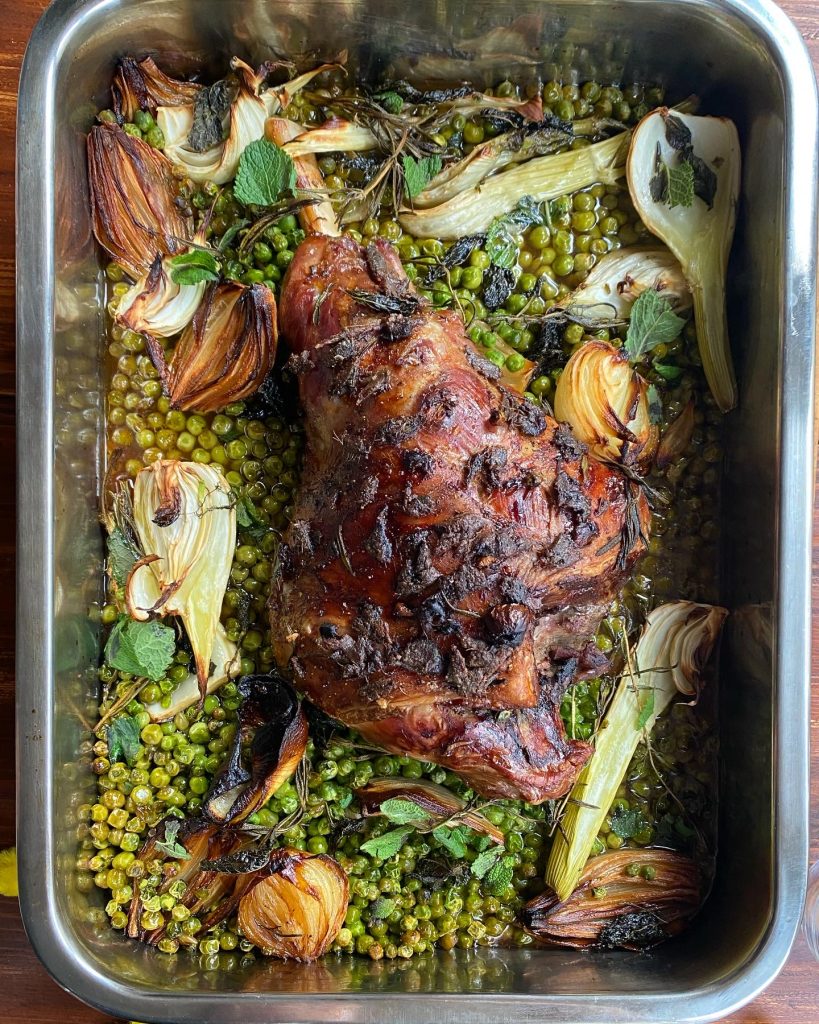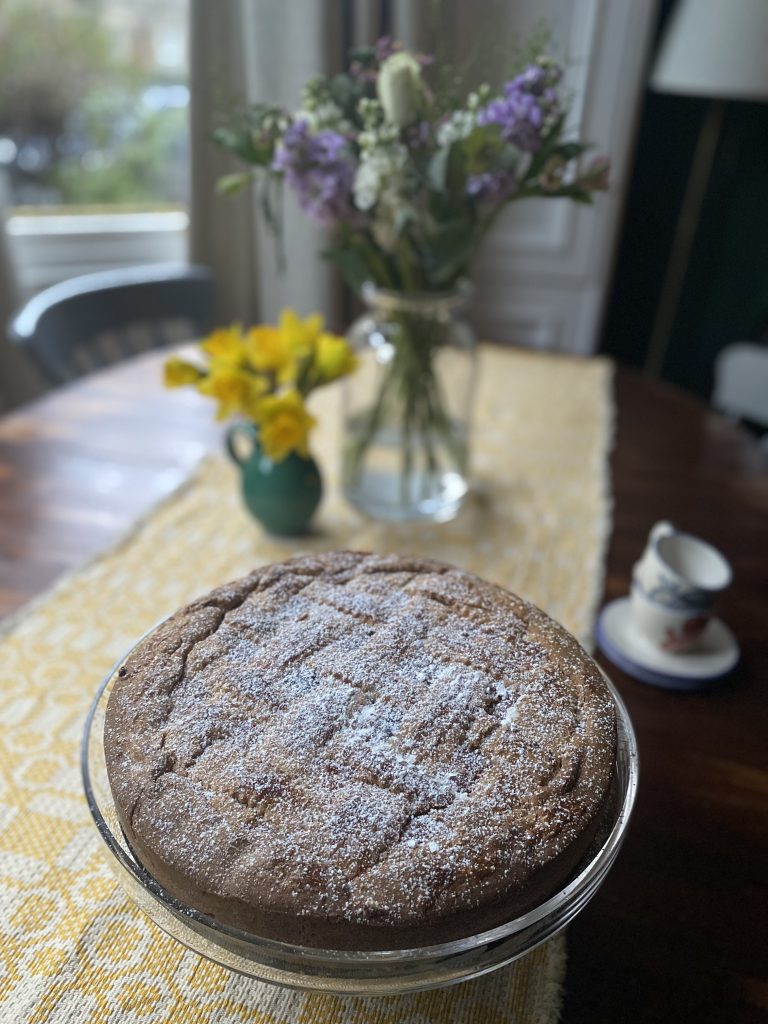Easter lamb with anchovies, garlic and rosemary
Being a predominantly Catholic country, Easter – or Pasqua – is one of the most important holidays of the year in Italy. As well as the various processions and religious rituals taking place, there is a strong emphasis on food at Easter in Italy. I have always enjoyed the fact that Easter brings less pressure than Christmas, but provides an opportunity to celebrate with family and to mark the beginning of springtime.

Lamb
Lamb is a classic Easter dish throughout Europe and the US and, in Italy, it is traditional to serve it with peas. The anchovies in this recipe add a salty, umami flavour to the lamb, and that richness is then balanced with the fresh, primavera flavours of the fennel, peas and mint.
Pastiera Napoletana
Pastiera Napoletana is a traditional Neapolitan Easter tart filled with grano cotto (cooked wheat), ricotta, and candied fruit. Much like spring, the orange blossom water, cinnamon and candied fruit that flavour the pastiera symbolise abundance and the forthcoming summer.
Although the dish originated in Naples, it is now popular throughout Italy. An ancient myth tells us that the dish was created by a mermaid, Parthenope. Parthenope was in Naples during springtime, and sang for the Neapolitans. As a thank you for her singing, the Neapolitans gifted Parthenope ricotta to symbolise abundance, flour to symbolise wealth, eggs to symbolise fertility, cooked wheat in milk to symbolise the fusion of the animal and vegetable kingdoms, sugar to symbolise the sweet song of Parthenope, spices to symbolise distant lands, and orange flowers to symbolise the Campanian earth. Parthenope gave these gifts to the gods who created the Pastiera Napoletana.
Another theory
A more recent theory involves the nuns of San Gregorio Armeno in Naples. A nun was making a cake using ingredients to symbolise the Resurrection – eggs as a symbol of fertility and wheat to symbolise rebirth. The nun decided to flavour the cake with the perfume of orange blossom from the orange trees growing in the convent’s garden. The pastiera was born and the nuns became famous for this dessert, preparing vast quantities for wealthy Neapolitan families.
However the Pastiera Napoletana originated, the fragrant flavours make it the perfect spring dessert, and it is particularly good after Easter lamb.
I hope you enjoy these recipes if you recreate them and that you have a wonderful Easter and spring.
Easter lamb with anchovies, garlic and rosemary
Ingredients (serves 6 to 8)
- 1.5kg to 2kg leg of lamb
- Extra virgin olive oil
- Salt and pepper
- 400g shallots, sliced in half lengthways
- 1 bulb of garlic, cloves peeled
- Small bunch of rosemary
- 2 tins of anchovies
- Small glass of white wine
- 2 to 3 bulbs of fennel, sliced into quarters lengthways
- 500g peas (frozen or fresh)
- Small bunch of mint
Method
- Preheat the oven to 220°C / 430°F.
- Add the shallots to the base of a roasting tin and drizzle with olive oil, salt and pepper.
- Place the lamb on top of the shallots and use a sharp knife to make small incisions all over the lamb. Add a garlic clove and small sprig of rosemary to each incision.
- Cut the anchovies roughly and use them to cover the lamb, then season well with black pepper (there is no need to add any salt – the anchovies will provide enough saltiness) and scatter the rest of the rosemary into the tin.
- Drizzle the lamb with olive oil and add the white wine to the tin, then put into the preheated oven for 20 minutes.
- After 20 minutes, reduce the heat to 180°C / 350°F. Cook the lamb for at least 2 hours (the longer the better). By this time, the anchovies will have formed a crust on the lamb. If necessary, cover the lamb with tin foil during this time.
- Add the fennel and a drizzle of olive oil to the tin, then put it back into the oven for a further 30 minutes.
- Then, add the peas and mint to the shallots and fennel. You may need to remove the lamb to do this. Put everything back into the oven for around 15 minutes, until the peas have cooked.
- Remove from the oven and let the lamb rest for 15 minutes or so before carving. The lamb should fall away very easily from the bone.
- Serve the lamb with the roasted shallots, fennel and peas. You could also serve some roasted rosemary potatoes with this dish. Buon appetito!
Pastiera Napoletana

Ingredients for pastry (pasta frolla – a sweet shortcrust pastry which is used in many Italian pastries, tarts and biscuits)
- 400g plain/all-purpose flour
- 200g granulated sugar
- 250g cold unsalted butter, cut into cubes
- 2 eggs
- 2 egg yolks
- Zest of one lemon
- Ingredients for filling
- 500g grano cotto (jars of pre-cooked grano cotto are available from Italian delis or online)
- 250ml milk
- 30g unsalted butter
- Zest of one orange
- 375g ricotta
- 3 eggs
- 200g granulated sugar
- 70g candied peel (I used candied cedro, but you could use candied orange or any type of candied citrus fruit)
- ¼ tablespoon cinnamon
- 1 tbsp orange blossom water
- A vanilla pod
- 1 egg, beaten
- Icing sugar to decorate
Method
- To make the pastry, add the flour, sugar and butter into a bowl and rub together until it resembles breadcrumbs. If you have a KitchenAid or stand mixer, you could use that to make it easier.
- Add the eggs, egg yolks and lemon zest, and mix together until the dough forms a smooth ball.
- Wrap the dough in cling film/plastic wrap and refrigerate for at least 1 hour.
- Meanwhile, make the filling. Add the grano cotto to a saucepan with the milk, butter and orange zest and heat on a medium heat, stirring constantly. Simmer for around 20 minutes or so, until it is creamy and has the texture similar to risotto. Remove from the heat and allow this mixture to cool.
- Mix the ricotta, eggs and sugar in a large bowl. Then, gradually add in the cooled grano cotto mixture.
- Add the candied peel, cinnamon, orange blossom water and the seeds of the vanilla pod to the mixture and mix well until everything is combined.
- Preheat the oven to 170°C / 340°F and lightly grease a springform cake tin.
- Remove the dough from the fridge and cut off around ¼ to decorate the top of the pastiera.
- Roll out the dough on a lightly floured surface until it is around ½ cm thick. Transfer this to the cake tin and carefully line the tin with the pastry. Use a fork to prick the pastry on the bottom of the tin.
- Add the grano cotto mixture to the tin, then cut off any excess pastry from the edges. Tap the tin on the worktop a couple of times to remove any air bubbles.
- Roll out the dough that you reserved earlier, again into around ½ cm thickness, and use a knife or pasta wheel to cut it into strips.
- Decorate the pastiera with the strips; I made a lattice pattern, but you can decorate it however you like. Trim off any excess dough.
- Use a pastry brush to lightly brush the beaten egg onto the pastry dough.
- Put the pastiera into the oven and bake for around 1 hour or until it is golden brown.
- Leave to cool completely before removing it from the tin, then dust with icing sugar before serving.
- Enjoy as a dessert or as breakfast with a cup of coffee. Buon appetito!

For more recipe ideas, follow Natalia on Instagram Buonappetitotutti.


Love these posts, from the delicious recipes to the narrative and the gorgeous photos!